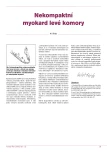Some patient groups with an acute heart attack subjected to an increased risk or requiring a specific therapeutic and diagnostic approach
Authors:
S. Janoušek
Authors‘ workplace:
LF MU a FN Brno, pracoviště Bohunice
; Interní kardiologická klinika
Published in:
Kardiol Rev Int Med 2006, 8(1-2): 25-26
Category:
Editorial
Overview
One of the ways to decrease mortality and improve prognosis in acute myocardial infarction (AMI) is identification of risk groups of patients or demanding specific therapeutic or diagnostic procedure. We can include in these risk groups patients with renal insufficiency, diabetes mellitus or the elderly and partly also women. Specific therapeutic approach is required in patients with right ventricle involvement, secondary prevention relaying more significantly on identification of possible inherited clotting or lipid metabolism abnormalities is necessary in young patients. The important group with diagnostic difficulties and substantially worse prognosis because of delayed diagnosis are the patients with silent AMI or manifesting by atypical symptoms.
Keywords:
acute myocardial infarction - risk groups of patients - renal failure - diabetes mellitus – seniors – women - right ventricle involvement - young patients - silent infarction - atypical symptoms
Sources
1. Fox KAA, Cokkinos DV, Deckers J et al on behalf of the ENACT. The ENACT study: a pan-European survey of acute coronary syndromes. Eur Heart J 2000; 21: 1440-1449.
2. Lampe FC, Whincup PH, Wannamethee SG et al. The natural history of prevalent ischaemic heart diseases in middle-aged men. Eur Heart J 2000; 21: 1052-1062.
3. Anavekar NS, McMurray JJ, Velazquez EJ et al. Relation between renal dysfunction and cardiovascular outcomes after myocardial infarction. N Engl J Med 2004; 351: 1285-1295.
4. Sadeghi HM, Stone GW, Grines CL et al. Impact of renal insufficiency in patients undergoing primary angioplasty for acute myocardial infarction. Circulation 2003; 108: 2769-2775.
5. Conti CR. Management of patients with acute myocardial infarction and end-stage renal disease. JACC 2003; 42: 209-210.
6. Mehran R, Aymong ED, Nikolsky E et al. A simple risk score for prediction of contrast-induced nephropathy after percutaneous coronary intervention. JACC 2004; 44(7): 1393-1399.
7. Marenzi G, Lauri G, Assanelli E et al. Contrast-induced nephropathy in patients undergoing primary angioplasty for acute myocardial infarction. JACC 2004; 44(9): 1780-1785.
8. Amann K, Tyralla K, Gross ML, Eifert T, Adamczak M, Ritz E. Special characteristics of atherosclerosis in chronic renal failure. Clin Nephrol 2003; 60(Suppl 1): 13-21.
9. Aoki J, Ong ATL, Hoye A et al. Five year clinical effect of coronary stenting and coronary artery bypass grafting in renal insufficient patients with multivessel coronary artery disease: insights from ARTS trial. Eur Heart J 2005; 26: 1488-1493.
10. Wahab NN, Cowden EA, Pearce NJ. Is blood glucose an independent predictor of mortality in acute myocardial infarction in the thrombolytic Era? JACC 2002; 40: 1748-1754.
11. The CREATE-ECLA Trial Group Investigators. Effect of glucose-insulin-potassium infusion on mortality in patients with acute ST-segment elevation myocardial infarction. JAMA 2005; 293: 437-446.
12. Abizaid A, Costa MA, Centemero M et al. Clinical and economic impact of diabetes mellitus on percutaneous and surgical treatment of multivessel coronary disease patients: Insights from the arterial revascularization therapy study (ARTS) trial. Circulation 2001; 104: 533-545.
13. Thiemann DR. Primary angioplasty for elderly patients with myocardial infarction. JACC 2002; 39: 1729-1732.
14. Holmes DR, White HD, Pieper KS. Effect of age on outcome with primary angioplasty versus thrombolysis. JACC 1999; 33: 412-419.
15. Gan SC, Beaver SK, Houck PM et al. Treatment of acute myocardial infarction and 30-day mortality among women and men. N Engl J Med; 343: 8-15.
16. MacIntyre K, Stewart S, Capewell S et al. Gender and survival: A population-based study of 201,114 men and women following a first acute myocardial infarction. JACC, 2001; 38: 729-735.
17. Goldstein JA. Pathophysiology and management of right heart ischemia. JACC 2002; 40: 841-853.
18. Zimetbaum PJ, Josephson ME. Use of the electrocardiogram in acute myocardial infarction. N Engl J Med 2003; 348: 933-943.
19. Klein LW, Nathan S. Coronary artery disease in young adults. JACC 2003; 41: 529-531.
20. Hennekens C, Evans D, Peto R. Oral contraceptive use, cigarette smoking and myocardial infarction. Br J Fam Plann 1989; 5: 66-67.
21. Cohn PF, Fox KM, Daly C. Silent myocardial ischemia. Circulation 2003; 108: 1263-1277.
22. Dorsch MF, Lawrance RA, Sapsford RJ et al. Poor prognosis of patients presenting with symptomatic myocardial infarction but without chest pain. Heart 2001; 86: 494-498.
Labels
Paediatric cardiology Internal medicine Cardiac surgery CardiologyArticle was published in
Cardiology Review

2006 Issue 1-2
Most read in this issue
- Hypertension in children and adolescents
- Diagnostic possibilities of peripheral arterial disease
- Non-pharmacologic therapy of arterial hypertension
- Sudden cardiac death: how to prevent it
